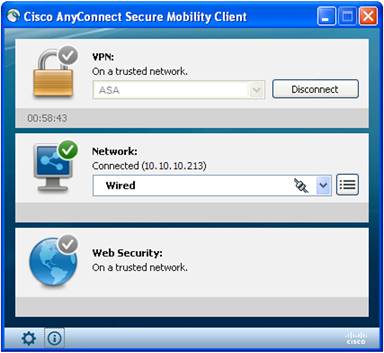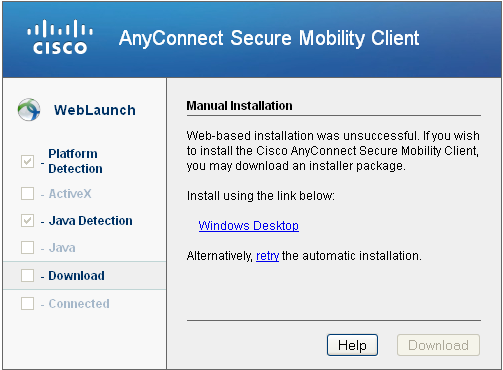Overview

Once you have finished downloading the manual installation, you are now ready to install. After completing the installation, you can now start the Cisco AnyConnect Secure Mobility Client. Launching the SSLVPN Client. If the web installation completes without failing the automatic session, you will be connected to the VPN. Click Next in the Cisco AnyConnect Secure Mobility Client Setup dialog box, then follow the steps to complete the installation. Starting the VPN Client. NOTE: The VPN will not connect if you are connected to the FBRI wired or wireless network. Go to Start-Programs-Cisco-Cisco AnyConnect Secure Mobility Client to launch the program.
- The University of Delaware allows you to use Virtual Private Network (VPN) client software to log in from off campus to UD resources usually restricted to on-campus use. VPN access is also required for access to certain UD business systems from off-campus or an unsecured wireless network.
- VPN software allows you to establish a secure, point-to-point connection over the Internet, in essence letting you connect to UDelNet as if you were on campus.
- We recommend you use Cisco's AnyConnect VPN client to connect to UD, and have pre-configured versions of AnyConnect for Windows, Macintosh, and Linux systems. AnyConnect is also available for iOS, Android, and Kindle devices.
. The new VPN client must be run from the 32-bit version of Internet Explorer to install properly. Contact CCIT Service Desk: Support Hours (864) 656-3494 ITHELP@clemson.edu. Help & Support Form Use this form to report a problem, ask for help or leave a comment. When autocomplete results are available use up and down arrows to review and enter to select.

Installation
Windows - Requires administrative access.
Cisco Anyconnect Vpn Client
- Right-Click on the downloaded file and select 'Run as administrator' to run.
- Accept all defaults.
macOS
- DO NOT double-click the installer as it will not successfully run that way. Instead, right-click on the AnyConnect.pkg and choose 'Open' from the pop-up menu to start the installer.
- On the ensuing dialog box that states, 'macOS cannot identify the developer...' of the app and asks, 'Are you sure you want to open the it?' choose 'Open.'
- Accept all defaults.

Linux

- Uncompress and unpack the tar file from the downloaded archive.
- The installer needs root privileges, so either log in as root or use the sudo command to run the shell script vpn_install.sh located in the VPN directory to install the AnyConnect VPN client.
iOS and Android Devices
Obtain the client software from Apple App Store or the Google Play Store and see configuration information link below.

Configuration
Directions for configuring the VPN software for all operating systems are located in the VPN Software help files. If you require further assistance, contact your department's or college's IT staff or the IT Support Center.Topics Map > Networking > Virtual Private Networking (VPN)
This page contains links to download and installation instructions for VPN software for Linux.
University of Illinois students, faculty, and staff can use these directions to set up some Linux computers or devices to connect to the Virtual Private Network (VPN).
Cisco-supported Versions
Some versions of Red Hat Linux and Ubuntu are compatible with the Cisco AnyConnect VPN client. See the AnyConnect 4.8 Release Notes for a detailed listing of which versions and features are supported.
Downloading the VPN software
From the WebStore, download the VPN software that applies to your system's hardware (only 64 bit is supported in the 4.x software).
If you are using Ubuntu, you may also need to install the OpenConnect Network Manager in order to make the GUI work correctly:
for Ubuntu 16 try:
for older versions of Ubuntu, this command might be needed.
The information below has been modeled on the University of California at Irvine instructions provided at:
Additional troubleshooting tips are available there.
Cisco Anyconnect Vpn Installation Log
Red Hat Linux
As root, first unzip and untar the file, then run the vpn_install shell script. [Note the file name and directory name will change as the version changes. The example below was from version 4.3.05017.]
The vpn client will be installed on your system and the vpnagentd process will be started. This process will be started each time your system is booted.
Starting the VPN client
To start the VPN client:
Command line:
In a terminal window, type/opt/cisco/anyconnect/bin/vpnuiGnome user interface:
Look for Cisco AnyConnect in the menu system.- Fedora:
Look in Applications -> Internet
The Connect to: box appears.
- Enter vpn.illinois.edu and press return.
When the connection begins, enter the following:
- Group menu: Select 1_SplitTunnel_Default
(Note: This is the most common choice. See About VPN Profiles for information about the alternatives, such as Tunnel All for access to library resources.) - Username: Your NetID
(or, if you're a guest, your guest ID) - Password: Your Active Directory password
(or, if you're a guest, your guest password)
In the box that appears, click Accept.
You are now ready to use your VPN connection.
Cisco Anyconnect Vpn Pc
Ubuntu
A good source to help with this: http://www.socsci.uci.edu/~jstern/uci_vpn_ubuntu/
First, extract the files and install as root:
Accept the license agreement when prompted.
Then install the Ubuntu Network Manager plugins (note, even with this package Ubuntu 16 does not support the GUI interface: see https://askubuntu.com/questions/760864/no-more-anyconnect-compatible-vpn-transport-in-ubuntu-16-04 for more information):
To configure the VPN using the Network Manager:
- Click on the 'Network Manager' icon in your System Tray on your desktop.
- In the menu that appears, go to VPN Connections -> Configure VPN
- Click Add.
- Choose Cisco AnyConnect Compatible VPN (openconnect) and click Create.
- Enter the following information:
- Connection name: Tech Services VPN
- Gateway: vpn.illinois.edu
- User name: Leave blank at this point.
- Click Save.
Starting the VPN client
- Click on the 'Network Manager' icon in your System Tray on your desktop.
- In the menu that appears, go to VPN Connections and click Tech Services VPN.
- Click on the connection icon (two screens).
- Enter the following information:
- Group menu: Select 1_SplitTunnel_Default
(Note: This is the most common choice. See About VPN Profiles for information about the alternatives.) - Username: Your NetID
(or, if you're a guest, your guest ID) - Password: Your Active Directory password
(or, if you're a guest, your guest password)
- Group menu: Select 1_SplitTunnel_Default
- Click Login.
sudo service network-manager restart
sudo service networking restart
Cisco Anyconnect Vpn Installer
Disconnecting the VPN client
- Click on the 'Network Manager' icon in your System Tray on your desktop.
- Go to VPN Connections -> Disconnect VPN.

Comments are closed.